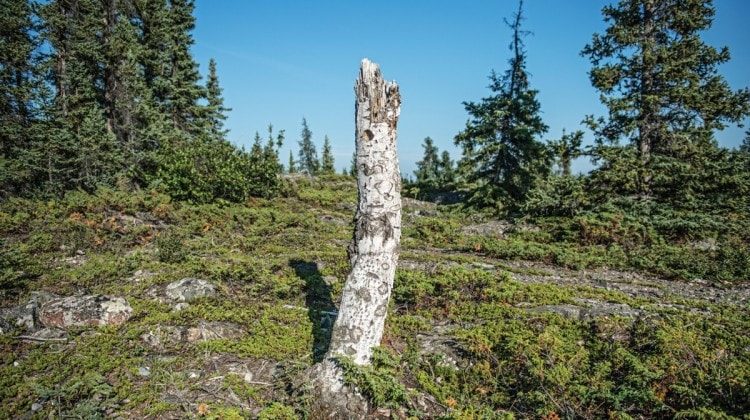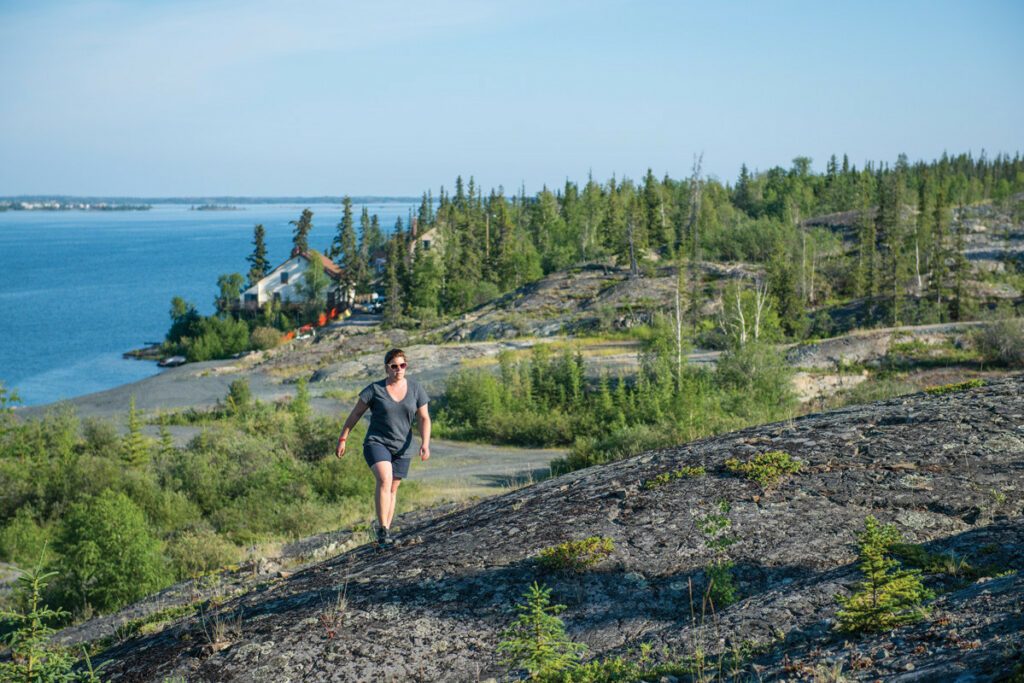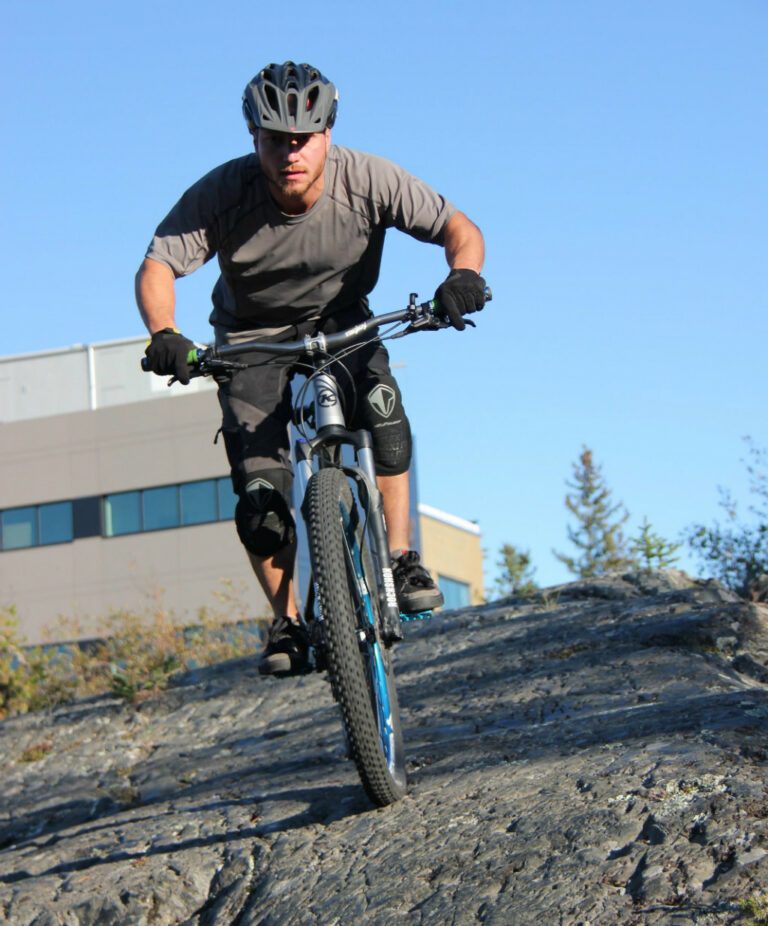When I first moved to Yellowknife, I lived in the Anderson Thomson Tower, the high-rise on the city’s east end. From there I could see what looked like a wilderness area, unbelievably close and easily accessed. It beckoned. My first venture was stopped short by “No Trespassing City of Yellowknife.” I paused, considering. Inside the gate, a dog followed his nose, excitedly zig-zagging through the brown grass. His human companion appeared oblivious to the no-trespassing edict. I stepped around the bar across the road – hardly a serious deterrent.
It was a cold Sunday afternoon in May 2008, pre-mosquito season, when I first followed that road up the hill, hidden from below by a pile of pillowy rock. Being brand new to Yellowknife, I asked myself if I should worry about bears. I stuck to the well-travelled road; nervous I might get lost and stay that way for a long time. After all, it was Tin Can Hill, where Mrs. Dargabble from Elizabeth Hay’s novel “Late Nights on Air” was found, frozen. I had just moved from Vancouver, where it takes hours to get to a trail, which, even then hosts a non-stop snake of hikers. Finding such a wild, unmanicured area a five-minute walk away was honestly like, well, discovering gold. I returned home for supper, happy with my new northern home.
Walkers, often with dogs, “cheeners” (snow-machiners) or mothers, three abreast, pushing jogging strollers, all enjoy Tin Can Hill for reverie, contemplation and camaraderie, attracted to that sanctuary of wild within a city. We might take our good fortune for granted. We might, like many do, think we are solitary in our discovery of this precious site, but Tin Can Hill has a long history, to say nothing of its primordial geological record. It is so named because it was an early dumping ground for emptied tins of supplies that used to arrive in Old Town by boat across Great Slave Lake.
According to Scott Cairns, chief geologist at the Geoscience Office in Yellowknife, Tin Can Hill, like other parts of Yellowknife, is volcanic rock of Precambrian age, 2.7 billion years old. Fluids heated to 600-800 C, from deep in the earth, squeezed through planes of weakness, cracks, faults and shearzones. Quartz and sulphide minerals were part of that molten load but another of those particles happened to be the one that has driven so much of the world’s history, gold. With Con Mine just south of Tin Can Hill, it wouldn’t be too surprising if some of that glitter is embedded under the feet of the many trail aficionados there.



In fact, from the ‘30s to the ‘50s, prospectors scattered over the hill with hammers and chisels, drilling trenches to house their dynamite sticks. Still, evidence of the rubble left from their blasts can be found on Tin Can Hill. They eventually hit pay dirt. A shearzone runs along the lakeshore and it is that zone where gold is embedded. Miners descended the Robertson head frame to ‘drifts’, or horizontal tunnels, 1.4 kilometres below the surface of Tin Can Hill, where Yellowknife’s early mining reputation was hidden. In those days, pumps kept the drifts dry, but now with the pumps de-commissioned, by 2016, those tunnels will be fully flooded.
Walt Humphries, a local rock-hound and columnist, recalls that regardless of its golden secrets, Tin Can Hill had another value for the Con miners. In early spring or late fall, when they couldn’t walk over the ice or put a canoe in the lake, the only route to get “to town” from the mines was over Tin Can Hill. That was when “town” was “Old Town.” The miners would go over the hill and drop down to School Draw, so named because the school was there at the time. One miner, Roy Beduz, remembered that it was also a route in the ‘60s and ‘70s followed by many a tardy Con kid. When they would miss the school bus, over the hill would be their last ditch attempt to beat the bell.
On Tin Can Hill there are still spots, protected from the city light, where the aurora are strong, un-diluted. One night, in search of the shimmering shape changers, I headed out with a friend who is obsessed with photographing the aurora, to our favourite spot. Instead of the silent cold, there were youthful voices, shouting, in party mode. The burned logs we had seen in a hollow on top of a meadow were explained. It was March break and those voices carried the thrill and impatience of budding romance; escape from school, from parents and routine. They may have thought they discovered the secluded meadow, but born-and-bred Yellowknifers remember the night-time allure of Tin Can Hill in the ‘70s, when teenagers would pass around Mason jars containing a concoction of pilfered, undetectably-small-quantities of liquor from every bottle in their parent’s cabinet.
It was Lower Camp, number seven, Lakeview Road, right across from Mosher Island, where Mayor Mark Heyck spent what he describes as a marvellous childhood. “It was an amazing, fantastic place to grow up, with Tin Can Hill as my playground.” The road over the hill served as a raceway, as did the barges which would anchor in front of the Heyck house. He and his buddies would wrap life-vests around their BMX bikes and cycle over the edge of the barges into the lake, a four-metre drop. Those were the days.
In Heyck’s time, the ‘70s and ‘80s, there were a small number of houses and the boiler house along the waterfront road, but before then, the south end of Tin Can Hill had been dotted with apartments, bunkhouses and a cookhouse. In those days, they covered buildings with asbestos siding to protect them from flying fire sparks. The life of mining activity produced a steady and pervasive hum, heard everywhere on Tin Can Hill. The buildings gradually came down, the men moved to New Town and the hush of wind in the spruce returned. By the ‘80s, Miramar, then owner of the mine holdings, severed its lease to the waterfront portion of Tin Can Hill and the City acquired it. It was slated to be the next residential sub-division, but there was so much opposition, city councillors turned their sights on Niven Lake area.
The City has put aside $60,000 of its capital budget for Tin Can Hill, and will be asking Yellowknifers how they’d like to see the money spent. Your thoughts are also welcome at a new website called tincanhill.org, operating under the mandate, “why we love tch.”






